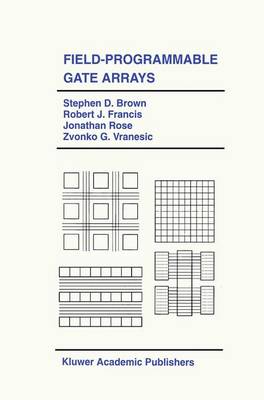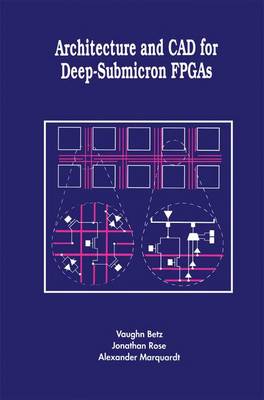The Springer International Series in Engineering and Computer Science
2 primary works
Book 180
Field-Programmable Gate Arrays
by Stephen D. Brown, Robert J. Francis, Jonathan Rose, and Zvonko G. Vranesic
Published 30 June 1992
Field-Programmable Gate Arrays (FPGAs) have emerged as an attractive means of implementing logic circuits, providing instant manufacturing turnaround and negligible prototype costs. They hold the promise of replacing much of the VLSI market now held by mask-programmed gate arrays. FPGAs offer an affordable solution for customized VLSI, over a wide variety of applications, and have also opened up new possibilities in designing reconfigurable digital systems.
Field-Programmable Gate Arrays discusses the most important aspects of FPGAs in a textbook manner. It provides the reader with a focused view of the key issues, using a consistent notation and style of presentation. It provides detailed descriptions of commercially available FPGAs and an in-depth treatment of the FPGA architecture and CAD issues that are the subjects of current research.
The material presented is of interest to a variety of readers, including those who are not familiar with FPGA technology, but wish to be introduced to it, as well as those who already have an understanding of FPGAs, but who are interested in learning about the research directions that are of current interest.
Field-Programmable Gate Arrays discusses the most important aspects of FPGAs in a textbook manner. It provides the reader with a focused view of the key issues, using a consistent notation and style of presentation. It provides detailed descriptions of commercially available FPGAs and an in-depth treatment of the FPGA architecture and CAD issues that are the subjects of current research.
The material presented is of interest to a variety of readers, including those who are not familiar with FPGA technology, but wish to be introduced to it, as well as those who already have an understanding of FPGAs, but who are interested in learning about the research directions that are of current interest.
Book 497
Architecture and CAD for Deep-Submicron FPGAS
by Vaughn Betz, Jonathan Rose, and Alexander Marquardt
Published 31 March 1999
Since their introduction in 1984, Field-Programmable Gate Arrays (FPGAs) have become one of the most popular implementation media for digital circuits and have grown into a $2 billion per year industry. As process geometries have shrunk into the deep-submicron region, the logic capacity of FPGAs has greatly increased, making FPGAs a viable implementation alternative for larger and larger designs. To make the best use of these new deep-submicron processes, one must re-design one's FPGAs and Computer- Aided Design (CAD) tools.
Architecture and CAD for Deep-Submicron FPGAs addresses several key issues in the design of high-performance FPGA architectures and CAD tools, with particular emphasis on issues that are important for FPGAs implemented in deep-submicron processes.
Three factors combine to determine the performance of an FPGA: the quality of the CAD tools used to map circuits into the FPGA, the quality of the FPGA architecture, and the electrical (i.e. transistor-level) design of the FPGA. Architecture and CAD for Deep-Submicron FPGAs examines all three of these issues in concert.
In order to investigate the quality of different FPGA architectures, one needs CAD tools capable of automatically implementing circuits in each FPGA architecture of interest. Once a circuit has been implemented in an FPGA architecture, one next needs accurate area and delay models to evaluate the quality (speed achieved, area required) of the circuit implementation in the FPGA architecture under test. This book therefore has three major foci: the development of a high-quality and highly flexible CAD infrastructure, the creation of accurate area and delay models for FPGAs, and the study of several important FPGA architectural issues.
Architecture and CAD for Deep-Submicron FPGAs is an essential reference for researchers, professionals and students interested in FPGAs.
Architecture and CAD for Deep-Submicron FPGAs addresses several key issues in the design of high-performance FPGA architectures and CAD tools, with particular emphasis on issues that are important for FPGAs implemented in deep-submicron processes.
Three factors combine to determine the performance of an FPGA: the quality of the CAD tools used to map circuits into the FPGA, the quality of the FPGA architecture, and the electrical (i.e. transistor-level) design of the FPGA. Architecture and CAD for Deep-Submicron FPGAs examines all three of these issues in concert.
In order to investigate the quality of different FPGA architectures, one needs CAD tools capable of automatically implementing circuits in each FPGA architecture of interest. Once a circuit has been implemented in an FPGA architecture, one next needs accurate area and delay models to evaluate the quality (speed achieved, area required) of the circuit implementation in the FPGA architecture under test. This book therefore has three major foci: the development of a high-quality and highly flexible CAD infrastructure, the creation of accurate area and delay models for FPGAs, and the study of several important FPGA architectural issues.
Architecture and CAD for Deep-Submicron FPGAs is an essential reference for researchers, professionals and students interested in FPGAs.

